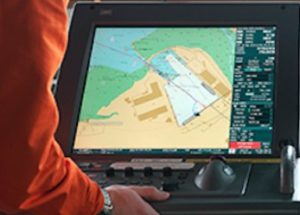The carriage of electronic chart display and information system (ECDIS) will be mandatory for all over 500 gross tonnage ships engaged on international voyages on 1st July 2018.
As per Resolution MSC.282(86), ECDIS application dates are defined for ships engaged on international voyages. ECDIS is regarded as an equivalent to paper charts as per SOLAS regulation V/19.2.1.4 and V/27.
Ship operators should ensure effective management and regular maintenance of both ECDIS hardware and software. Comprehensive guidance is available as per IMO Circular MSC.1/Circ.1503 ‘ECDIS Guidance for Good Practice’.
Ship operators and Masters should take into account ECDIS-related issues including: ECDIS type approval certificate, record of equipment to Safety Equipment Certificate, listing of ECDIS as critical equipment, ECDIS software maintenance, periodic tests and checks, back-up arrangements, Bridge Officers training and familiarisation, appropriate planning and monitoring settings, alignment with sensors input.
The requirement for familiarisation is recognized under the provisions of section 6.3 and 6.5 of the ISM code. Ship operators and Masters should ensure that appropriate training and familiarisation will be incorporated into the Company’s management system for the use of ECDIS. Familiarisation should be built on previously completed ECDIS generic training.

Master and navigating officers should be familiarized with the specific make and model of the ECDIS equipment on-board (and backup procedure) before taking charge of a navigational watch. Resources provided by the ECDIS manufacturers(CD or/and DVD) may be a part of ECDIS familiarisation. The Master is expected to verify that all officers in charge of a navigational watch are competent in the safe and effective use of the ship’s ECDIS.
Refresh training must be undertaken by all masters and officers in charge of a navigational watch on ECDIS-fitted ships, especially for those who had an approved training program before 1 July 2013.
ECDIS familiarisation should follow a structured plan and cover the following areas: familiarisation with available functions, familiarisation with the menu structure, display setup, setting of safety values, alarms and malfunction indicators recognition and related actions to be taken, route planning and monitoring, changing over to backup systems, loading charts and licenses, updating of software.
Many Port State control inspectors expect to see documented evidence for type specific ECDIS training (type specific ECDIS training certificates). Trickle-down-familiarisation (e.g. one officer training another) is not acceptable by many PSC inspectors due to an unstructured familiarisation procedure or due to no proper competence in the use of the equipment installed on-board.
Source: MSC.282(86), MSC.1/Circ.1503, MSC.232(82)
Contact us to receive a professional advisory in your area of interest.
